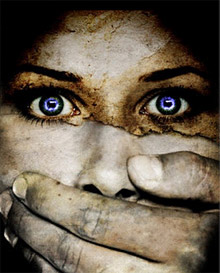
|  |  |  News Around the Republic of Mexico News Around the Republic of Mexico  
Fear Muzzles Journalists on US Border
 Lynn Brezosky - San Antonio Express-News Lynn Brezosky - San Antonio Express-News
go to original
March 19, 2010


| | Reporters and photographers live under two rulers: the elected officials who may be corrupt; and narcotraffickers who set the guidelines on what can — and can't — be reported. |  |
Reynosa, Mexico — Banner headlines on the front pages of city newspapers early this week screamed about cartel-related violence: Across the border in McAllen, a shooting had left two men seriously wounded. Hundreds of miles away in Juárez, a frantic shootout had killed three people affiliated with the U.S. Consulate.

But amid those stories, not a word was printed about the ongoing drug war taking place in town. And because of threats, there wasn't a single account about six missing journalists, presumed to have been abducted nearly three weeks ago.

Indeed, when journalists who flout the unwritten rules to not cover certain stories go missing or turn up dead or beaten, their colleagues gulp down the message.

“We were once accustomed to working freely, to go pursue things,” said Víctor González Treviño, regional coordinator of the Union of Democratic Journalists of Tamaulipas. “Now we have to know, ‘Is this OK, Is that OK?'

“The bad guys are monitoring us all the time. They know who's doing what — and where.”

Treviño, among the few openly discussing the terror that has infiltrated his trade, spoke in a guarded voice at a coffee shop around the corner from the city's main plaza, which bustled this week with a student dance show and townsfolk enjoying a school vacation.

While editors at two Reynosa newspapers declined to talk, Treviño said he wasn't scared.

“We are part of this war. They advise us,” he said, referring broadly to voices over Nextel phones that order, sometimes hours in advance, which sections of town or roads to avoid.

The local police seem to get the messages too, he said, with shootouts regularly devoid of sirens and patrol cars.

Reporters and photographers, he said, live under two rulers: the elected officials who may be corrupt; and narcotraffickers who set the guidelines on what can — and can't — be reported.

“The ones who die are each other,” he said. “They even remove the bodies themselves. I limit myself to the city news, the politics.”

Treviño said the missing journalists include two photographers and a freelance reporter from El Mañana, the area's largest newspaper; two from the newspaper La Prensa; and the owner of Metronoticias, a news Web site.

Their abductions have sparked an outcry from groups including the Committee to Protect Journalists and the Inter-American Press Association.

In recent weeks, residents of Reynosa and the border city of Miguel Alemán have told the San Antonio Express-News the unprecedented climate of fear there has been worsened by a dearth of information in local media.

The city of Reynosa has established a Twitter account to dispel rumors. Most of the official tweets have reported calm.

The Committee to Protect Journalists has documented 44 deaths of Mexican journalists since 1992, with 19 killed for reasons directly related to their work, said Carlos Lauría, senior program coordinator.

The recent violence and self-censorship is reminiscent of Colombia's drug war, but conditions there have improved in part because the government now provides journalists in imminent risk protection such as bodyguards and bulletproof cars, he said.

The latest wave of violence broke out in mid-February, ending a time of relative peace in the state of Tamaulipas, across the Texas border and extending from Brownsville to Laredo.

Drug war experts attribute the spate to a turf battle between the Gulf Cartel and Los Zetas, their former wing of military-trained assassins. The experts, ranging from government intelligence agents to college professors, predict a prolonged bloodbath.

The battles haven't been limited to Tamaulipas or to the two factions. Ciudad Juárez, across from El Paso, remained the deadliest in the Western Hemisphere. On Sunday, three people affiliated with the U.S. Consulate there were killed as they left a birthday party. Two were U.S. citizens. Officials now say it may have been a case of mistaken identity.

Treviño said Mexican journalists remain dedicated to their profession, despite the “self-censorship.”

“Most of us want to have liberty of expression,” he said, “so people can have more information on how to stay safe.”
|

 |
|  |



